Olympus CV-180 User manual
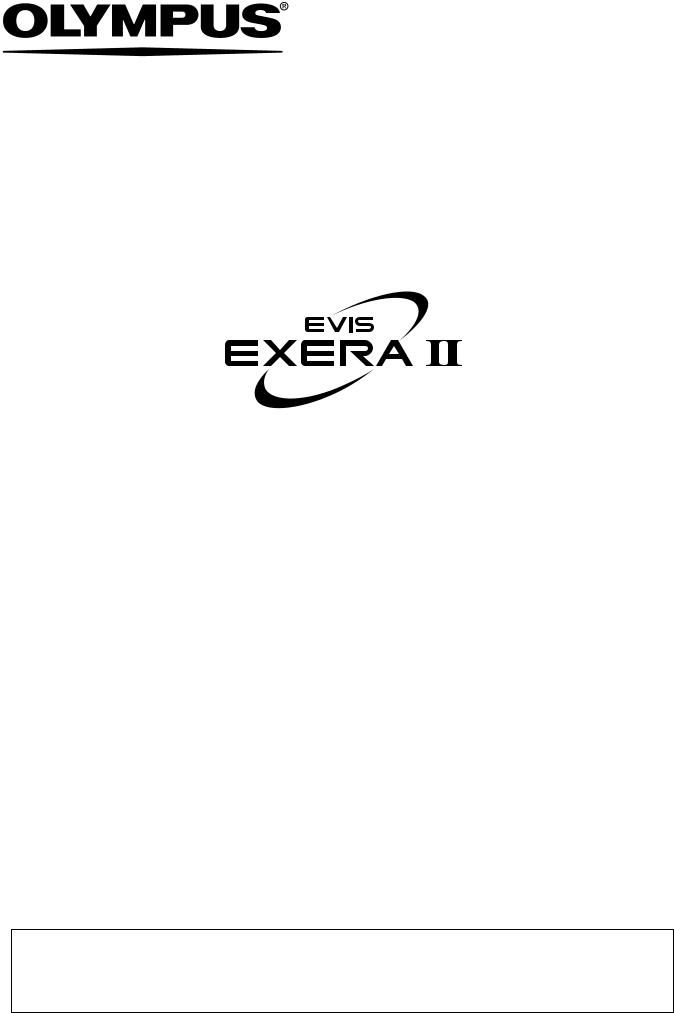
INSTRUCTIONS
EVIS EXERA II VIDEO SYSTEM CENTER
OLYMPUS CV-180
USA: CAUTION: Federal law restricts this device to sale by or on the order of a physician.

Contents
Contents
Labels and Symbols..................................................................... |
1 |
|
Important Information — Please Read Before Use.................... |
3 |
|
Intended use ............................................................................................ |
3 |
|
Instruction manual .................................................................................... |
3 |
|
User qualifications .................................................................................... |
5 |
|
Instrument compatibility ........................................................................... |
5 |
|
Repair and modification ............................................................................ |
6 |
|
Signal words ............................................................................................. |
6 |
|
Dangers, warnings and cautions............................................................... |
7 |
|
Cardiac applications.................................................................................. |
11 |
|
Summary of Equipment Functions ............................................. |
12 |
|
Chapter 1 Checking the Package Contents............................ |
14 |
|
Chapter 2 Nomenclature and Functions................................. |
15 |
|
2.1 |
Front panel...................................................................................... |
15 |
2.2 |
Rear panel ...................................................................................... |
19 |
2.3 |
Keyboard......................................................................................... |
22 |
2.4 |
Side panels ..................................................................................... |
27 |
2.5 |
Videoscope cable EXERA II (MAJ-1430)........................................ |
27 |
2.6 |
Set-up of screen options ................................................................. |
28 |
2.7 |
Monitor ............................................................................................ |
29 |
2.8 |
Pointer............................................................................................. |
33 |
Chapter 3 |
Inspection ................................................................ |
34 |
3.1 |
Inspection of the power supply ....................................................... |
35 |
3.2 |
Inspection of the examination light.................................................. |
36 |
3.3 |
Inspection of the automatic brightness control function .................. |
37 |
3.4 |
Inspection of the monitor display .................................................... |
38 |
3.5 |
Inspection of the freeze function ..................................................... |
39 |
3.6 |
Inspection of the release function ................................................... |
39 |
3.7 |
Inspection of the PinP (picture in picture) function.......................... |
39 |
3.8 |
Inspection of the orientation function .............................................. |
39 |
3.9 |
Inspection of the special light observation function......................... |
40 |
3.10 |
Inspection of the scope switches and foot switches ....................... |
40 |
EVIS EXERA II VIDEO SYSTEM CENTER CV-180 |
i |
|

Contents
3.11 Power OFF...................................................................................... |
40 |
Chapter 4 |
Operation.................................................................. |
41 |
4.1 |
Operation flow................................................................................. |
44 |
4.2 |
Connection of an endoscope .......................................................... |
46 |
4.3 |
Turning the video system center ON............................................... |
50 |
4.4 |
Recall of user preset data ............................................................... |
51 |
4.5 |
White balance adjustment............................................................... |
52 |
4.6 |
Patient data..................................................................................... |
57 |
4.7 |
Observation of the endoscopic image............................................. |
59 |
4.8 |
Recording of the observation image ............................................... |
59 |
4.9 |
Termination of the operation ........................................................... |
60 |
|
Chapter 5 |
Functions.................................................................. |
62 |
|
5.1 |
Front panel...................................................................................... |
62 |
|
|
Image source buttons............................................................................ |
62 |
|
|
PinP (picture in picture) display............................................................. |
64 |
|
|
Image enhancement mode (ENH.)........................................................ |
67 |
|
|
Iris mode................................................................................................ |
69 |
|
|
White balance........................................................................................ |
70 |
|
|
Brightness adjustment (Exposure) ........................................................ |
71 |
|
|
STOP button and PC card indicator ...................................................... |
75 |
|
|
PC card slot and eject button ................................................................ |
76 |
|
|
RESET button ....................................................................................... |
80 |
|
5.2 |
Keyboard......................................................................................... |
81 |
|
|
Domepoint ............................................................................................. |
81 |
|
|
Clearing characters from the screen (“F1”) ........................................... |
82 |
|
|
System setup (“Shift” + “F1”)................................................................. |
84 |
|
|
Scope information (“F2”) ....................................................................... |
84 |
|
|
User preset (“Shift” + “F2”) .................................................................... |
85 |
|
|
Cursor (“F3”).......................................................................................... |
85 |
|
|
Patient data (“Shift” + F3)...................................................................... |
86 |
|
|
Freeze mode (“F4”) ............................................................................... |
86 |
|
|
Browse (“Shift” + “F4”)........................................................................... |
87 |
|
|
Stopwatch (“F5”).................................................................................... |
88 |
|
|
Automatic gain control (AGC) (“F6”)...................................................... |
89 |
|
|
Contrast mode (“Shift” + “F6”) ............................................................... |
90 |
|
|
Image zooming (“F7”)............................................................................ |
91 |
|
|
Color bar (“Shift” + “F7”)........................................................................ |
93 |
|
|
Image size (“F8”) ................................................................................... |
94 |
|
|
Printer lock (“Shift” + “F8”)..................................................................... |
95 |
|
|
Image enhancement (“F9”).................................................................... |
96 |
|
|
White balance adjustment (“Shift” + “F9”) ............................................. |
97 |
|
|
Color tone adjustment (“COLOR”)......................................................... |
98 |
|
|
Freeze (“FREEZE”) ............................................................................... |
99 |
|
|
Release (“RELEASE”)........................................................................... |
101 |
|
|
Arrow pointer (“Shift” + arrow keys and domepoint).............................. |
102 |
|
|
|
|
ii |
EVIS EXERA II VIDEO SYSTEM CENTER CV-180 |
|
|

|
|
Contents |
|
Color mode (“Shift” + “Alt” + “1”, “2”, “3”, “4”)........................................ |
104 |
|
Ending examination (“EXAM END”)...................................................... |
105 |
5.3 |
Image recording and playback (PC card) ....................................... |
106 |
|
Storage level of the PC card................................................................. |
106 |
|
Recording the frozen image on a PC card............................................ |
108 |
|
PC card menu....................................................................................... |
110 |
|
Basic operation of the PC card menu ................................................... |
111 |
|
Formatting of the PC card..................................................................... |
114 |
|
Playback images from the PC card ...................................................... |
115 |
|
Deleting images from a PC card........................................................... |
117 |
|
Deleting folder from PC card ................................................................ |
118 |
|
Annotation of images............................................................................ |
119 |
|
Playback image annotation................................................................... |
122 |
|
Playback the images using the personal computer .............................. |
124 |
|
Image files and folders.......................................................................... |
125 |
5.4 |
Image recording and playback (other than PC card) ...................... |
127 |
|
Image filing system............................................................................... |
127 |
|
Videocassette recorder (VCR).............................................................. |
129 |
5.5 |
Printing images ............................................................................... |
131 |
|
Video printer ......................................................................................... |
131 |
5.6 |
Pre-entry of patient data ................................................................. |
136 |
|
Basic operation in the patient menu ..................................................... |
136 |
|
Entering new patient data..................................................................... |
137 |
|
Displaying patient data ......................................................................... |
140 |
|
Editing previously entered patient data................................................. |
141 |
|
Deleting previously entered patient data .............................................. |
142 |
|
Clearing all patient data previously entered.......................................... |
143 |
|
Recording patient data into PC card..................................................... |
144 |
|
Loading patient data from PC card....................................................... |
146 |
5.7 |
Scope information ........................................................................... |
148 |
|
Displaying and entering scope information........................................... |
149 |
5.8 |
Special light observation ................................................................. |
151 |
|
NBI (narrow band imaging)................................................................... |
151 |
Chapter 6 |
Fuse replacement.................................................... |
153 |
Chapter 7 Care, Storage and Disposal.................................... |
155 |
|
7.1 |
Care ................................................................................................ |
155 |
7.2 |
Storage ........................................................................................... |
156 |
7.3 |
Disposal .......................................................................................... |
156 |
EVIS EXERA II VIDEO SYSTEM CENTER CV-180 |
iii |

Contents
Chapter 8 Installation and Connection.................................... |
157 |
|
8.1 |
Installation work flow....................................................................... |
158 |
8.2 |
Installation of the equipment ........................................................... |
159 |
8.3 |
Fitting of accessories ...................................................................... |
162 |
8.4 |
Light source .................................................................................... |
164 |
8.5 |
Monitor ............................................................................................ |
170 |
8.6 |
Keyboard......................................................................................... |
178 |
8.7 |
Videocassette recorder (VCR) ........................................................ |
179 |
8.8 |
Video printer.................................................................................... |
181 |
8.9 |
OLYMPUS flushing pump (OFP) .................................................... |
183 |
8.10 |
Foot switch...................................................................................... |
184 |
8.11 |
Ultrasound center............................................................................ |
185 |
8.12 |
Connection to the AC mains power supply ..................................... |
189 |
|
Chapter 9 |
Function setup......................................................... |
193 |
|
9.1 |
Turning power ON........................................................................... |
193 |
|
9.2 |
System setup .................................................................................. |
194 |
|
|
Basic operation of the system setup ..................................................... |
194 |
|
|
System .................................................................................................. |
197 |
|
|
Printer.................................................................................................... |
201 |
|
|
Image filing system................................................................................ |
206 |
|
|
Monitor .................................................................................................. |
208 |
|
|
Videocassette recorder ......................................................................... |
211 |
|
|
Saving the system setup ....................................................................... |
213 |
|
|
Summary of settings.............................................................................. |
214 |
|
9.3 |
User preset ..................................................................................... |
216 |
|
|
Basic operation of the user preset......................................................... |
216 |
|
|
Remote switch and foot switch (EXERA and VISERA) ......................... |
219 |
|
|
Release function.................................................................................... |
223 |
|
|
Recording format for PC card................................................................ |
224 |
|
|
Freeze function...................................................................................... |
225 |
|
|
Image enhancement (normal observation)............................................ |
226 |
|
|
Color mode............................................................................................ |
228 |
|
|
Image size ............................................................................................. |
229 |
|
|
Iris.......................................................................................................... |
232 |
|
|
Iris speed............................................................................................... |
235 |
|
|
Auto gain control (AGC) ........................................................................ |
237 |
|
|
Contrast................................................................................................. |
238 |
|
|
Exposure area ....................................................................................... |
239 |
|
|
Electronic shutter................................................................................... |
240 |
|
|
Patient data display ............................................................................... |
241 |
|
|
Scope nickname.................................................................................... |
242 |
|
|
Release index time................................................................................ |
243 |
|
|
Indication of the special light observation.............................................. |
244 |
|
|
Monitor orientation function ................................................................... |
245 |
|
|
|
|
iv |
EVIS EXERA II VIDEO SYSTEM CENTER CV-180 |
|
|

|
Contents |
PinP (picture in picture) function........................................................... |
246 |
Special light observation....................................................................... |
250 |
Image enhancement (NBI observation) ................................................ |
250 |
Saving the user preset.......................................................................... |
251 |
Resetting the user preset data to the factory defaults .......................... |
252 |
Deleting user preset data...................................................................... |
253 |
Summary of settings............................................................................. |
255 |
Chapter 10 Troubleshooting ...................................................... |
259 |
10.1 Troubleshooting guide .................................................................... |
259 |
10.2 Returning the video system center for repair .................................. |
268 |
Appendix ....................................................................................... |
269 |
System chart ............................................................................................ |
269 |
Transportation, storage, and operation environment ................................ |
276 |
Specifications ........................................................................................... |
276 |
EMC information ....................................................................................... |
282 |
EVIS EXERA II VIDEO SYSTEM CENTER CV-180 |
v |

Contents
vi |
EVIS EXERA II VIDEO SYSTEM CENTER CV-180 |
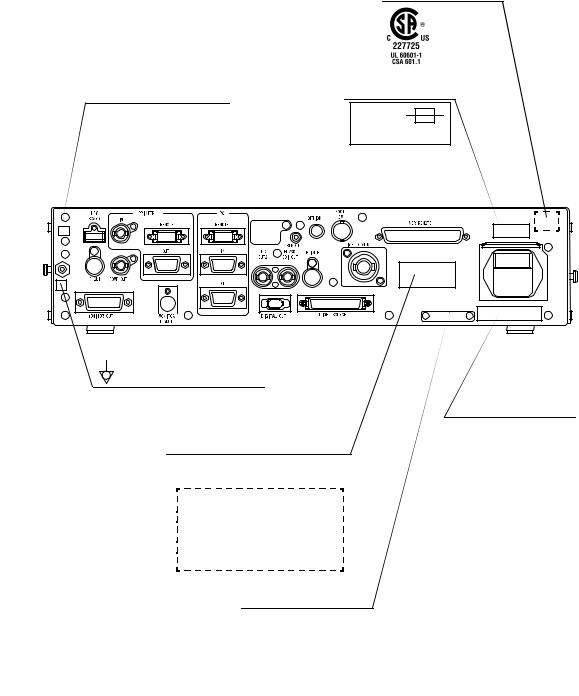
Labels and Symbols
Labels and Symbols
Safety-related labels and symbols are attached on the locations shown below. If labels or symbols are missing or illegible, contact OLYMPUS.
Rear panel
CSA/UL marking
Fuse rating
Caution that only the exclusive cable can be connected.
Potential equalization terminal
Electric rating
FUSES
T5AL250V
Manufacturer name
The product name, rated voltage and frequency are shown.
EVIS EXERA II
VIDEO SYSTEM CENTER MODEL OLYMPUS CV-180 INPUT 100-240V
50/60Hz 150VA
Serial number plate
EVIS EXERA II VIDEO SYSTEM CENTER CV-180 |
1 |

Labels and Symbols
Back cover of this instruction manual
Manufacturer
Authorized representative in the European Community
2 |
EVIS EXERA II VIDEO SYSTEM CENTER CV-180 |

Important Information — Please Read Before Use
Important Information — Please Read
Before Use
Intended use
This video system center has been designed to be used with OLYMPUS camera heads, endoscopes, light sources, monitors, endo-therapy accessories and other ancillary equipment for endoscopic diagnosis, treatment and video observation. Do not use this video system center for any purpose other than its intended use.
Instruction manual
This instruction manual contains essential information on using this video system center safely and effectively. Before use, thoroughly review this manual and the manuals of all equipment which will be used during the procedure and use the equipment as instructed.
Keep this and all related instruction manuals in a safe, accessible location. If you have any questions or comments about any information in this manual, please contact Olympus.
Terms used in this manual
Light source:
The light source provides light and electrical signals to the endoscope. It also provides electrical signals to the video system center.
Video printer:
The video printer is a device that prints the frozen video image.
Wall mains outlet:
The wall mains outlet is a wall AC mains power outlet socket having the exclusive terminal for grounding.
Isolation transformer:
The isolation transformer is a safety device that is used to isolate noninsulated equipment with potentially high leakage currents to decrease the possibility of electric shock.
Image sensor (CCD):
Image sensor (CCD) is a device that converts light into electrical signals.
EVIS EXERA II VIDEO SYSTEM CENTER CV-180 |
3 |

Important Information — Please Read Before Use
Automatic brightness control:
The automatic brightness control automatically adjusts the intensity of the light emitted from the light source so that the endoscopic image will be maintained at constant brightness even if the distance between the distal end of the endoscope's insertion tube and the subject changes.
Color adjustment:
Color adjustment adjusts the color balance on the video monitor.
Iris:
The iris function is used to electrically measure the brightness of an endoscopic image to obtain a control signal for the purpose of automatic light adjustment.
Freeze:
The freeze function creates a stationary view of the moving image.
Release:
The release function is used to capture and record an endoscopic image.
Edge enhancement:
Edge enhancement is an image processing technique that electronically sharpens the edges of an image.
Structure enhancement:
Structure enhancement is an image processing technique that electronically emphasizes the detailed patterns and edges of an image to increase sharpness.
PinP (Picture in picture):
PinP function displays both the image of the endoscopic live image and the image of an external device on the monitor simultaneously.
PC card:
A digital medium for storage of images, etc.
Wash out:
Wash out is the inability to see details in the endoscopic image due to excessive brightness.
HDTV:
High Definition Television. This is a format for high resolution video transmission featuring higher definition than the standard SDTV format.
4 |
EVIS EXERA II VIDEO SYSTEM CENTER CV-180 |

Important Information — Please Read Before Use
SDTV:
Standard Definition Television. It is the format used in standard video systems.
Special light observation:
This is a observation using filtered light.
NBI (narrow band imaging):
This is one of the special light observations using the narrow band observation light.
User qualifications
If there is an official standard on user qualifications to perform endoscopy and endoscopic treatment that is defined by the medical administration or other official institutions, such as academic societies on endoscopy, follow that standard. If there is no official qualification standard, the operator of this instrument must be a physician approved by the medical safety manager of the hospital or person in charge of the department (department of internal medicine, etc.).
The physician should be capable of safely performing the planned endoscopy and endoscopic treatment following guidelines set by the academic societies on endoscopy, etc., and considering the difficulty of endoscopy and endoscopic treatment. This manual does not explain or discuss endoscopic procedures.
Instrument compatibility
Refer to the “System chart” in the Appendix to confirm that this video system center is compatible with the ancillary equipment being used. Using incompatible equipment can result in patient injury or equipment damage and makes it impossible to obtain the expected functionality.
This instrument complies with the EMC standard for medical electrical equipment; edition 2 (IEC 60601-1-2: 2001). However, when connecting to an instrument that complies with the EMC standard for medical electrical equipment; edition 1 (IEC 60601-1-2: 1993), the whole system complies with edition 1.
EVIS EXERA II VIDEO SYSTEM CENTER CV-180 |
5 |

Important Information — Please Read Before Use
Repair and modification
This video system center does not contain any user-serviceable parts. Do not disassemble, modify or attempt to repair it; patient or operator injury, equipment damage and/or the impossibility to obtain the expected functionality can result. Some problems that appear to be malfunctions may be correctable by referring to Chapter 10, “Troubleshooting”. If the problem cannot be resolved using the information in Chapter 10, contact Olympus. This instrument is to be repaired by Olympus technicians only.
Signal words
The following signal words are used throughout this manual:
Indicates an imminently hazardous situation which, if not avoided, will result in death or serious injury.
Indicates a potentially hazardous situation which, if not avoided, could result in death or serious injury.
Indicates a potentially hazardous situation which, if not avoided, may result in minor or moderate injury. It may also be used to alert against unsafe practices or potential equipment damage.
Indicates additional helpful information.
6 |
EVIS EXERA II VIDEO SYSTEM CENTER CV-180 |

Important Information — Please Read Before Use
Dangers, warnings and cautions
Follow the dangers and cautions given below when handling this video system center. This information is to be supplemented by the dangers and cautions given in each chapter.
•Strictly observe the following precautions. Failure to do so may place the patient and medical personnel in danger of electric shock.
When this video system center is used to examine a patient, do not allow metal parts of the endoscope or its accessories to touch metal parts of other system components. Such contact may cause unintended current flow to the patient.
Keep fluids away from all electrical equipment. If fluids are spilled on or into the unit, stop operation of the video system center immediately and contact Olympus.
Do not prepare, inspect or use this video system center with wet hands.
•Never install and operate the video system center in locations where:
the concentration of oxygen is high;
oxidizing agents (such as nitrous oxide (N2O)) are present in the atmosphere;
flammable gases are present in the atmosphere;
flammable liquids are near.
Otherwise, explosion or fire may result because this video system center is not explosion-proof.
EVIS EXERA II VIDEO SYSTEM CENTER CV-180 |
7 |

Important Information — Please Read Before Use
•In case of instrument failure or malfunction, always keep another video system center in the room ready for use.
•Never insert anything into the ventilation grills of the video system center. It can cause an electric shock and/or fire.
•Although the illumination light emitted from the endoscope's distal end is required for endoscopic observation and treatment, it may also cause alteration of living tissues such as protein denaturation of liver tissue and perforation of the intestines by inappropriate use.
Observe the following warnings on the illumination.
Always set the minimum required brightness. The brightness of the image on a video monitor may differ from the actual brightness at the distal end of an endoscope. Especially in combination with endoscopes using an electrical shutter function, pay attention to the brightness level setting of the light source. When this instrument is used with a light source compatible with automatic brightness control function, be sure to use this function. The automatic brightness control function can keep the illumination light properly. Refer to the instruction manual of the light source for details.
Do not continue observation in the proximity to tissue or keep the distal end of the endoscope in contact with living tissue for a long time. It may cause patient burns.
When discontinuing the use of the endoscope, be sure to turn the light source OFF so that the endoscope does not irradiate unnecessary light.
•This product may interfere with other medical electronic equipment used in combination with it. Before use, refer to the Appendix to confirm the compatibility of this instrument with all equipment to be used.
•Do not use this product in any place where it may be subject to strong electromagnetic radiation (for example, in the vicinity of a microwave therapeutic device, MRI, wireless set, short-wave therapeutic device, cellular/portable phone, etc.). This may impair the performance of the product.
8 |
EVIS EXERA II VIDEO SYSTEM CENTER CV-180 |

Important Information — Please Read Before Use
•If the endoscopic image dims during use, blood, mucus or debris may adhere to the light guide on the distal end of the endoscope. Carefully withdraw the endoscope from the patient and remove the blood or mucus in order to obtain optimum illumination and to ensure the safety of the examination. If you continue to use the endoscope in such a condition, the distal end temperature may rise and cause mucosal burns. It may also cause patient and/or operator injury.
•Do not rely on the special light observation method alone for primary detection of lesions or for a decision regarding any potential diagnostic or therapeutic intervention.
•For reasons described below, do not rely on the NBI imaging modality alone for primary detection of lesions or to make a decision regarding any potential diagnostic or therapeutic intervention.
It has not been demonstrated to increase the yield or sensitivity of finding any specific mucosal lesion including colonic polyps or Barrett’s esophagus.
•To display observation images, connect the output terminal of the video system center directly to the monitor. Do not make the connection via any ancillary equipment. Images may disappear during observation depending on the condition of ancillary equipment.
•Do not use a pointed or hard object to press the buttons on the front panel and/or keyboard. This may damage the buttons.
•Do not touch the electrical contacts inside the video system center's connectors.
•Do not apply excessive force to this video system center and/or other instruments connected. Otherwise, damage and/or malfunction can occur.
•Do not connect or disconnect the endoscope connector while this video system center is turned ON. Connecting or disconnecting the endoscope while this video system center is ON may destroy the CCD. Turn the video system center OFF before connecting or disconnecting the endoscope.
•Clean and vacuum dust the ventilation grills using a vacuum cleaner, when necessary. Otherwise, the video system center may break down and gets damaged from overheating.
EVIS EXERA II VIDEO SYSTEM CENTER CV-180 |
9 |

Important Information — Please Read Before Use
•Be sure that this instrument is not used adjacent to or stacked with other equipment (other than the components of this instrument or system) to avoid electromagnetic interference.
•Electromagnetic interference may occur to this instrument when it is placed near equipment marked with the following symbol or other portable and mobile RF communications equipment such as cellular phones. If radio interference occurs, mitigation measures may be necessary, such as reorienting or relocating this instrument or shielding the location.
As defined by the international safety standard (IEC 60601- 1), medical electrical equipment is classified into the following types: TYPE CF applied part (the instrument can safely be applied to any part of the body, including the heart), and TYPE B/BF applied part (the instrument can safely be applied to any organ except the heart). The part of the body that an endoscope or electrosurgical accessory can safely be applied to depends on the classification of the equipment to which the instruments are connected. Before beginning the procedure, check the current leakage classification type of each instrument to be used for the procedure. Classification types are clearly specified in the instruments' instruction manuals.
Symbol |
Classification |
|
|
TYPE CF applied part
TYPE BF applied part
TYPE B applied part
10 |
EVIS EXERA II VIDEO SYSTEM CENTER CV-180 |

Important Information — Please Read Before Use
Cardiac applications
•Use only the devices listed in the “System chart” in the Appendix for endoscopic observation or treatment of the heart or areas near the heart. Other combinations of equipment may cause ventricular fibrillation or seriously affect the cardiac function of the patient.
•For cardiac applications, never support the endoscope with a metal surgical arm which is not electrically isolated from the ground. If not isolated, the endoscope will be connected to the ground through the surgical arm and bed, and will conduct unexpected leakage current which may seriously affect the cardiac function of the patient.
•The use of medical devices not specifically designed for cardiac applications may cause ventricular fibrillation or seriously affect the cardiac function of the patient. As specified by the international standard IEC 60601-1, any applied part used for observation or treatment of the heart or areas near the heart must meet “TYPE CF applied part” requirements for low electrical leakage current. When using endoscopes for endoscopic cardiac applications, the applied part requirements include all devices directly connected to the endoscope, such as the light guide cable, camera head and telescope holder. Each of these devices must individually meet the “TYPE CF applied part” requirements for leakage current limits if they are to be used for cardiac applications.
The OLYMPUS light guide cables and camera heads listed in the “System chart” in the Appendix (TYPE CF applied part) which are suitable for cardiac applications bear a  mark.
mark.
EVIS EXERA II VIDEO SYSTEM CENTER CV-180 |
11 |

Summary of Equipment Functions
Summary of Equipment Functions
This instrument is a system controller of the endoscopic image observation system that displays, records and prints the endoscopic images. Some of the functions of this instrument described below are enabled only when the required equipment are connected to this instrument. For more details, refer to the instruction manuals for this instrument and the other instruments connected.
Displaying the endoscopic images on the monitor
•The endoscopic live image and the other images of, for example, the ultrasonic endoscope connected to this instrument can be displayed on the monitor.
•The endoscopic image and other external images can be displayed on the same monitor at the same time (PinP function).
“PinP (picture in picture) display” on page 64
•Either a standard-definition (SDTV) monitor or high-definition (HDTV) monitor can be used.
Special light observation
Endoscopic observation using filtered light is available.Section 5.8, “Special light observation” on page 151
Adjusting the endoscopic images
Images can be adjusted to enable clear and convenient observation.
•Adjustment of the image color
“Color tone adjustment (“COLOR”)” on page 98
•Adjustment of the image brightness
“Brightness adjustment (Exposure)” on page 71
•Changing the iris mode
“Iris mode” on page 69
•Changing the contrast mode
“Contrast mode (“Shift” + “F6”)” on page 90
•Enhancement of edge lines and patterns of the images“Image enhancement mode (ENH.)” on page 67
•Changing the image size
“Image size (“F8”)” on page 94
12 |
EVIS EXERA II VIDEO SYSTEM CENTER CV-180 |

Summary of Equipment Functions
•Enlargement of the images
“Image zooming (“F7”)” on page 91
Entering patient data
•The patient data such as name, sex, etc. can be entered and displayed on the monitor with the endoscopic live image.
Section 4.6, “Patient data” on page 57 and Section 5.6, “Pre-entry of patient data” on page 136.)
•Up to 40 sets of patients data can be stored on the PC card. These patient data can be copied to the other CV-180.
“Recording patient data into PC card” on page 144
Customizing the operations
Up to 20 remote switch settings and other functions such as iris mode, image enhancement, etc., can be stored.
Section 9.3, “User preset” on page 216
Recording images
•The endoscopic image can be recorded on the PC card.
Section 5.3, “Image recording and playback (PC card)” on page 106
•The endoscopic image can be recorded on the image-recording device connected to this instrument, and the recorded images can be played back.
Section 5.4, “Image recording and playback (other than PC card)” on page 127
•The endoscopic image can be printed from the printer connected to this instrument.
Section 5.5, “Printing images” on page 131
Operation of ancillary equipment
•Video casette recorder
“Videocassette recorder (VCR)” on page 129
•Video printer
Section 5.5, “Printing images” on page 131
•Image filing system
“Image filing system” on page 127
EVIS EXERA II VIDEO SYSTEM CENTER CV-180 |
13 |
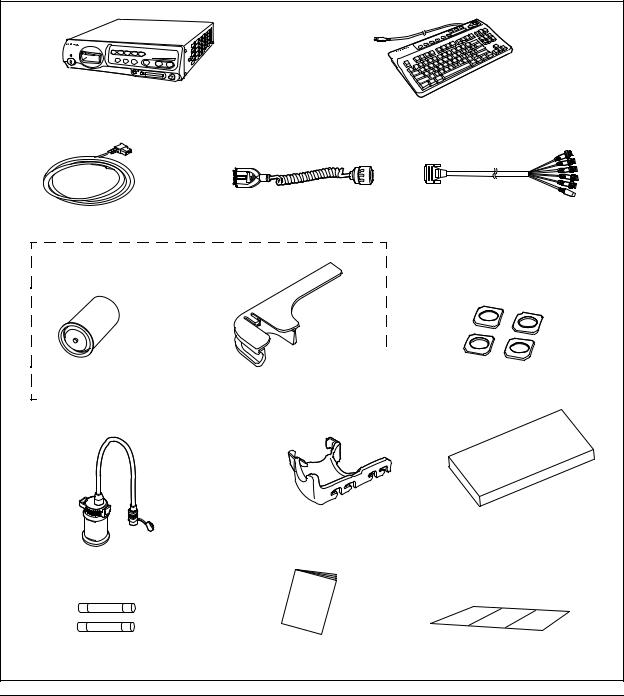
Chapter 1 Checking the Package Contents
Chapter 1 Checking the Package
Contents
Match all items in the package with the components shown below. Inspect each item for damage. If the instrument is damaged, a component is missing or you have any questions, do not use the instrument; immediately contact Olympus.
Video system center (CV-180)
Keyboard (MAJ-1428)
|
Videoscope cable EXERA II |
HDTV/SDTV monitor cable |
Power cord |
(MAJ-1430) |
|
|
|
(MAJ-1462) |
White cap (MH-155) |
White cap holder (MAJ-960) |
|
Foot holder (MAJ-1433, 4 pcs.) |
||||||||||||||||||||||||||||||||||||
|
|||||||||||||||||||||||||||||||||||||||
|
|||||||||||||||||||||||||||||||||||||||
|
|
|
|
|
|
|
|
|
|
|
|
|
|
|
|
|
|
||||||||||||||||||||||
|
|
|
|
|
|
|
|
|
|
|
|
|
|
|
|
|
|
|
|
|
|
|
|
|
|
|
|
|
|
|
|
|
|
|
|
|
|
|
|
|
|
|
|
|
|
|
|
|
|
|
|
|
|
|
|
|
|
|
|
|
|
|
|
|
|
|
|
|
|
|
|
|
|
|
|
|
|
|
|
|
|
|
|
|
|
|
|
|
White cap set (MAJ-941) |
|
|
|
|
|
|
|
|
|
|
|
|
|
|
|
|
||||||||||||||
Scope cable holder (MAJ-1466) |
Keyboard cover |
|
(MAJ-1557) |
Water container (MAJ-901)
Spare fuse (MAJ-1432, 2 pcs.) Instruction manual Cable color sheet
14  EVIS EXERA II VIDEO SYSTEM CENTER CV-180
EVIS EXERA II VIDEO SYSTEM CENTER CV-180
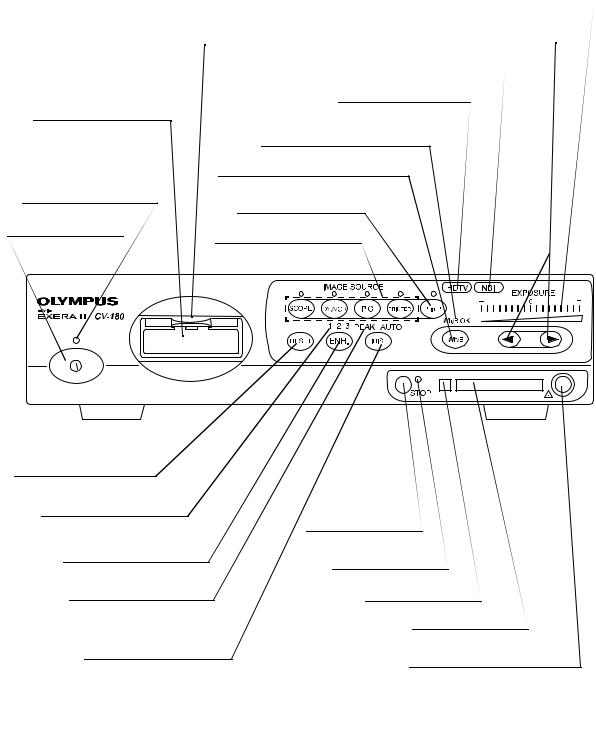
Chapter 2 Nomenclature and Functions
Chapter 2 Nomenclature and Functions
2.1 Front panel
|
|
|
|
12. Exposure level |
||
|
|
|
|
(EXPOSURE) indicator |
||
|
|
|
11. Exposure adjustment |
|||
4. Locking lever |
|
|
|
(EXPOSURE) buttons |
|
|
|
|
10. NBI indicator |
|
|||
|
|
|||||
3.Video connector socket
2.Power indicator
1.Power
22.RESET button
21.Image enhancement mode indicators
20.Image enhancement mode (ENH.) button
19.Iris mode indicators
18.Iris mode (IRIS) button
9.HDTV indicator
8.White balance (Wh/B OK) indicator
7.White balance (Wh/B) button
6.Picture in picture (PinP) button
5.Image source buttons
button
card
Eject button
14. PC card
13. PinP composite terminal
EVIS EXERA II VIDEO SYSTEM CENTER CV-180 |
15 |

Chapter 2 Nomenclature and Functions
1.Power switch
Press to turn the video system center ON or OFF.
2.Power indicator
Lights up when the video system center is ON.
3.Video connector socket
The video plug of the videoscope cable, videoscope or camera head are connected to this socket.
4.Locking lever
Press down to disconnect the video plug of the videoscope cable, videoscope or camera head.
5.Image source buttons
Press these buttons to select the image sources to be displayed on the monitor. Press and hold the buttons to change (except “SCOPE”).
“Image source buttons” on page 62
Button |
The image on the monitor |
|
|
SCOPE |
The endoscopic live image |
|
|
DV/VCR |
The image of the videocassette recorder, etc. |
|
|
PC |
The image of the image filing system |
|
|
PRINTER |
The image of the video printer |
6.Picture in picture (PinP) button
Press to display an image of the connected ancillary equipment and the endoscopic live image together on the monitor.
•Setting of the PinP function
“PinP (picture in picture) function” on page 246
•Operation of the PinP function
“PinP (picture in picture) display” on page 64
7.White balance (Wh/B) button
Press to perform the white balance adjustment.
Section 4.5, “White balance adjustment” on page 52
8.White balance (Wh/B OK) indicator
The indicator lights up when the white balance adjustment is completed.
9.HDTV indicator
Lights up green when the instrument is turned ON, and turns white when the HDTV compatible endoscope is connected to this instrument.
10.NBI indicator
Lights up green when the NBI compatible endoscope is connected to this instrument, and turns white during NBI observation. This indicator works only when the light source CLV-180 is used.
“NBI (narrow band imaging)” on page 151
16 |
EVIS EXERA II VIDEO SYSTEM CENTER CV-180 |

Chapter 2 Nomenclature and Functions
11.Exposure adjustment (EXPOSURE) buttons
Press to adjust the brightness of the observation light. When CLV-180 is used, this button is interlocked with the “BRIGHTNESS” on CLV-180.
“Brightness adjustment (Exposure)” on page 71
12.Exposure level (EXPOSURE) indicator
Indicates the brightness level of the observation light.
“Brightness adjustment (Exposure)” on page 71
13.PinP composite terminal
The ultrasound center (EUS), endoscope position detecting unit (UPD) etc. can be connected to this connector to input the images to be displayed together with the endoscopic observation image. The PinP function can also be used with the PinP Y/C terminal on the rear panel. However, the PinP composite terminal takes priority over the PinP Y/C terminal.
14.PC card slot
Insert the PC card adapter (optional) in this slot. The xD picture card can be used as the storage media.
“PC card slot and eject button” on page 76
15.Eject button
Press to remove the PC card from the PC card slot.
“PC card slot and eject button” on page 76
16.PC card status indicator
This indicator lights up green when the PC card is inserted into the PC card slot, and blinks orange while accessing the PC card.
“PC card slot and eject button” on page 76
17.STOP button
Press to stop accessing the PC card. Be sure to press this button before removing the PC card from the PC card slot.
“PC card slot and eject button” on page 76
18.Iris mode (IRIS) button
Press to switch the iris mode (brightness adjustment method) of the endoscopic image. Either “AUTO” or “PEAK” mode can be selected.
•Presetting
“Iris” on page 232
•Switching operation“Iris mode” on page 69
19.Iris mode indicators
Indicates the iris mode being selected.
EVIS EXERA II VIDEO SYSTEM CENTER CV-180 |
17 |

Chapter 2 Nomenclature and Functions
20.Image enhancement mode (ENH.) button
“Image enhancement” refers to facilitate observation of edges and patterns of the endoscopic image by electronic treatment. Press this button to change the modes of the enhancement methods.
•Presetting
“Image enhancement (normal observation)” on page 226 or “Image enhancement (NBI observation)” on page 250
•Operation
“Image enhancement mode (ENH.)” on page 67
21.Image enhancement mode indicators
One of these indicators light up and indicates the image enhancement mode being selected. The indicator goes off when the image enhancement is not used.
22.RESET button
Press and hold the switch to return the settings changed during operation to the default settings.
“RESET button” on page 80
18 |
EVIS EXERA II VIDEO SYSTEM CENTER CV-180 |

2.2Rear panel
8.PC remote terminal
7.PC IN terminal
6.PC OUT terminal
5.Printer remote terminal
4.Printer OUT terminal
3.Printer IN terminal
2.Y/C OUT terminal
1.Keyboard terminal
Potential equalization terminal
22.Monitor terminal
21.Composite terminal
20.Monitor remote terminal
19.PC OUT2 terminal
Chapter 2 Nomenclature and Functions
9.Remote terminal
10.Foot switch terminal
11.VCR remote terminal
12.Fuse box
power inlet
14.Light control terminal
15.Light source terminal
16.PinP Y/C terminal
17.HD/SD SDI OUT terminal
18.Digital OUT terminal
EVIS EXERA II VIDEO SYSTEM CENTER CV-180 |
19 |

Chapter 2 Nomenclature and Functions
1.Keyboard terminal
Connect the keyboard.
2.Y/C OUT terminal
Outputs a Y/C video signals.
3.Printer IN terminal
Connect the video printer. Inputs the analog video signal from the video printer.
4.Printer OUT terminal
Connect the video printer. Outputs the analog video signal to the video printer.
5.Printer remote terminal
Connect the video printer. Establishes communication with the video printer.
6.PC OUT terminal
Connect the image filing system. Outputs the analog video signal to the image filing system.
7.PC IN terminal
Connect the image filing system. Inputs the analog video signal from the image filing system.
8.PC remote terminal
Connect the image filing system. Establishes communication with the image filing system.
9.Remote terminal
Outputs the signal synchronizing the release and VCR (Rec/Pause) operation.
10.Foot switch terminal
Connect the foot switch.
11.VCR remote terminal
Connect an Olympus-recommended VCR. Outputs the analog video signal and the remote signals to the VCR.
12.Fuse box
Stores the fuses that protect the instrument from electrical surges.
13.AC power inlet
Connect the provided power cord to supply the AC power via this inlet.
14.Light control terminal
Connect a light source that supports the analog interface.
15.Light source terminal
Connect a light source CLV-180 that supports the digital interface.
20 |
EVIS EXERA II VIDEO SYSTEM CENTER CV-180 |

Chapter 2 Nomenclature and Functions
16.PinP Y/C terminal
The ultrasound center (EUS), endoscope position detecting unit (UPD) etc. can be connected to this connector to input the image to be displayed together with the endoscopic observation image. The PinP function can also be used with the PinP composite terminal on the front panel. However, the PinP composite terminal takes priority over the PinP Y/C terminal.
17.HD/SD SDI OUT terminal
Connect a monitor compatible with the serial digital interface (SDI). Outputs the SDI signal.
18.Digital OUT terminal
Connect an Olympus-recommended digital video recorder to output and input the digital video signal to the digital video recorder, using IEEE1394 cable.
19.PC OUT2 terminal
Connect the image filing system. Outputs an SDI signal to the image filing system.
20.Monitor remote terminal
Connect the monitor. Outputs the monitor control signal to the monitor.
21.Composite OUT terminal
Outputs the composite video signal.
22.Monitor OUT terminal
Connect the monitor. Outputs analog video signals to the monitor. HDTV signal is output when the HDTV compatible endoscope is connected. This connector can output a 180 rotated image (see “Monitor orientation function” on page 245).
23.Potential equalization terminal
This terminal is connected to a potential equalization terminal of the other equipment connected to this instrument. The electric potential of their equipment are made equal.
EVIS EXERA II VIDEO SYSTEM CENTER CV-180 |
21 |
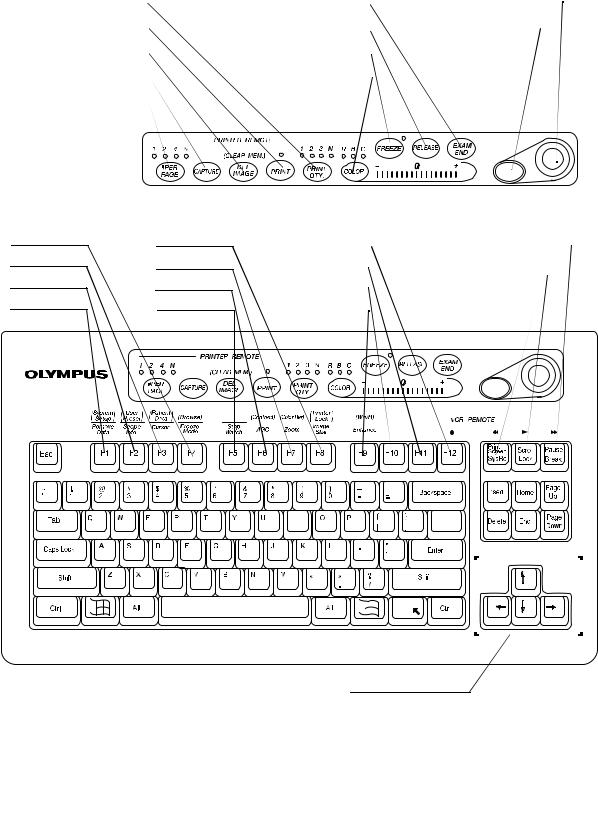
Chapter 2 Nomenclature and Functions
2.3Keyboard
20. PRINT QTY. key |
|
|
|
24. EXAM END key |
|
|
26. Domepoint |
||||||||||
|
|
|
|
|
|
|
|
|
|
|
|
|
|
Click key |
|
||
19. |
PRINT key |
|
|
|
|
|
|
key |
|
|
|||||||
|
|
|
|
|
|
|
|
|
|
|
|
|
|
||||
18. DEL IMAGE key |
|
|
|
|
|
|
key |
|
|
|
|
|
|
||||
17. |
CAPTURE key |
|
|
|
|
|
key |
|
|
|
|
|
|
||||
16. #PER PAGE key |
|
|
|
|
|
|
|
|
|
|
|
|
|
|
|||
|
|
|
|
|
|
|
|
|
|
|
|
|
|
|
|
|
|
|
|
|
|
|
|
|
|
|
|
|
|
|
|
|
|
|
|
|
|
|
|
|
|
|
|
|
|
|
|
|
|
|
|
|
|
4. F4 key
3.F3 key
2.F2 key
1. F1 key
8. F8 key |
key |
key |
key |
|
|
|
|
|
|
12. F12 key |
|
|
|
|
|
|
|
|
|
15. Pause key |
|
|
|
|
||||||||||||||||||||||||||||||||||||||||
|
|
|
|
|
|
|
|
|
F11 key |
|
|
|
|
|
|
|
|
|
Scroll lock key |
|
|
|
|
|
||||||||||||||||||||||||||||||||||||
|
|
|
|
|
|
|
|
|
F10 key |
|
|
|
|
|
|
|
|
|
|
|
|
|
||||||||||||||||||||||||||||||||||||||
|
|
|
|
|
|
|
|
|
|
|
|
|
Print screen key |
|
|
|
|
|||||||||||||||||||||||||||||||||||||||||||
|
|
|
|
|
|
|
|
|
F9 key |
|
|
|
|
|
|
|
|
|||||||||||||||||||||||||||||||||||||||||||
|
|
|
|
|
|
|
|
|
|
|
|
|
|
|
|
|
|
|
|
|
|
|
|
|
|
|
|
|
|
|
|
|
|
|
|
|
|
|
|
|
|
|
|
|
|
|
|
|
|
|
|
|
|
|
|
|
|
|
|
|
|
|
|
|
|
|
|
|
|
|
|
|
|
|
|
|
|
|
|
|
|
|
|
|
|
|
|
|
|
|
|
|
|
|
|
|
|
|
|
|
|
|
|
|
|
|
|
|
|
|
|
|
|
|
|
|
|
|
|
|
|
|
|
|
|
|
|
|
|
|
|
|
|
|
|
|
|
|
|
|
|
|
|
|
|
|
|
|
|
|
|
|
|
|
|
|
|
|
|
|
|
|
|
|
|
|
|
|
|
|
|
|
|
|
|
|
|
|
|
|
|
|
|
|
|
|
|
|
|
|
|
|
|
|
|
|
|
|
|
|
|
|
|
|
|
|
|
|
|
|
|
|
|
|
|
|
|
|
|
|
|
|
|
|
|
|
|
|
|
|
|
|
|
|
|
|
|
|
|
|
|
|
|
|
|
|
|
|
|
|
|
|
|
|
|
|
|
|
|
|
|
|
|
|
|
|
|
|
|
|
|
|
|
|
|
|
|
|
|
|
|
|
|
|
|
|
|
|
|
|
|
|
|
|
|
|
|
|
|
|
|
|
|
|
|
|
|
|
|
|
|
|
|
|
|
|
|
|
|
|
|
|
|
|
|
|
|
|
|
|
|
|
|
|
|
|
|
|
|
|
|
|
|
|
|
|
|
|
|
|
|
|
|
|
|
|
|
|
|
|
|
|
|
|
|
|
|
|
|
|
|
|
|
|
|
|
|
|
|
|
|
|
|
|
|
|
|
|
|
|
|
|
|
|
|
|
|
|
|
|
|
|
|
|
|
|
|
|
|
|
|
|
|
|
|
|
|
|
|
|
|
|
|
|
|
|
|
|
|
|
|
|
|
|
|
|
|
|
|
|
|
|
|
|
|
|
|
|
|
|
|
|
|
|
|
|
|
|
|
|
|
|
|
|
|
|
|
|
|
|
|
|
|
|
|
|
|
|
|
|
|
|
|
|
|
|
|
|
|
|
|
|
|
|
|
|
|
|
|
|
|
|
|
|
|
|
|
|
|
|
|
|
|
|
|
|
|
|
|
|
|
|
|
|
|
|
|
|
|
|
|
|
|
|
|
|
|
|
|
|
|
|
|
|
|
|
|
|
|
|
|
|
|
|
|
|
|
|
|
|
|
|
|
|
|
|
|
|
|
|
|
|
|
|
|
|
|
|
|
|
|
|
|
|
|
|
|
|
|
|
|
|
|
|
|
|
|
|
|
|
|
|
|
|
|
|
|
|
|
|
|
|
|
|
|
|
|
|
|
|
|
|
|
|
|
|
|
|
|
|
|
|
|
|
|
|
|
|
|
|
|
|
|
|
|
|
|
|
|
|
|
|
|
|
|
|
|
|
|
|
|
|
|
|
|
|
|
|
|
|
|
|
|
|
|
|
|
|
|
|
|
|
|
|
|
|
|
|
|
|
|
|
|
|
|
|
|
|
|
|
|
|
|
|
|
|
|
|
|
|
|
|
|
|
|
|
|
|
|
|
|
|
|
|
|
|
|
|
|
|
|
|
|
|
|
|
|
|
|
|
|
|
|
|
|
|
|
|
|
|
|
|
|
|
|
|
|
|
|
|
|
|
|
|
|
|
|
|
|
|
|
|
|
|
|
|
|
|
|
|
|
|
|
|
|
|
|
|
|
|
|
|
|
|
|
|
|
|
|
|
|
|
|
|
|
|
|
|
|
|
|
|
|
|
|
|
|
|
|
|
|
|
|
|
|
|
|
|
|
|
|
|
|
|
|
|
|
|
|
|
|
|
|
|
|
|
|
|
|
|
|
|
|
|
|
|
|
|
|
|
|
|
|
|
|
|
|
|
|
|
|
|
|
|
|
|
|
|
|
|
|
|
|
|
|
|
|
|
|
|
|
|
|
|
|
|
|
|
|
|
|
|
|
|
|
|
|
|
|
|
|
|
|
|
|
|
|
|
|
|
|
|
|
|
|
|
|
|
|
|
|
|
|
|
|
|
|
|
|
|
|
|
|
|
|
|
|
|
|
|
|
|
|
|
|
|
|
|
|
|
|
|
|
|
|
|
|
|
|
|
|
|
|
|
|
|
|
|
|
|
|
|
|
|
|
|
|
|
|
|
|
|
|
|
|
|
|
|
|
|
|
|
|
|
|
|
|
|
|
|
|
|
|
|
|
|
|
|
|
|
|
|
|
|
|
|
|
|
|
|
|
|
|
|
|
|
|
|
|
|
|
|
|
|
|
|
|
|
|
|
|
|
|
|
|
|
|
|
|
|
|
|
|
|
|
|
|
|
|
|
|
|
|
|
|
|
|
|
|
|
|
|
|
|
|
|
|
|
|
|
|
|
|
|
|
|
|
|
|
|
|
|
|
|
|
|
|
|
|
|
|
|
|
|
|
|
|
|
|
|
|
|
|
|
|
|
|
|
|
|
|
|
|
|
|
|
|
|
|
|
|
|
|
|
|
|
|
|
|
|
|
|
|
|
|
|
|
|
|
|
|
|
|
|
|
|
|
|
|
|
|
|
|
|
|
|
|
|
|
|
|
|
|
|
|
|
|
|
|
|
|
|
|
|
|
|
|
|
|
|
|
|
|
|
|
|
|
|
|
|
|
|
|
|
|
|
|
|
|
|
|
|
|
|
|
|
|
|
|
|
|
|
|
|
|
|
|
|
|
|
|
|
|
|
|
|
|
|
|
|
|
|
|
|
|
|
|
|
|
|
|
|
|
|
|
|
|
|
|
|
|
|
|
|
|
|
|
|
|
|
|
|
|
|
|
|
|
|
|
|
|
|
|
|
|
|
|
|
|
|
|
|
|
|
|
|
|
|
|
|
|
|
|
|
|
|
|
|
|
|
|
|
|
|
|
|
|
|
|
|
|
|
|
|
|
|
|
|
|
|
|
|
|
|
|
|
|
|
|
|
|
|
|
|
|
|
|
|
|
|
|
|
|
|
|
|
|
|
|
|
|
|
|
|
|
|
|
|
|
|
|
|
|
|
|
|
|
|
|
|
|
|
|
|
|
|
|
|
|
|
|
|
|
|
|
|
|
|
|
|
|
|
|
|
|
|
|
|
|
|
|
|
|
|
|
|
|
|
|
|
|
|
|
|
|
|
|
|
|
|
|
|
|
|
|
|
|
|
|
|
|
|
|
|
|
|
|
|
|
|
|
|
|
27. Arrow keys
22 |
EVIS EXERA II VIDEO SYSTEM CENTER CV-180 |
